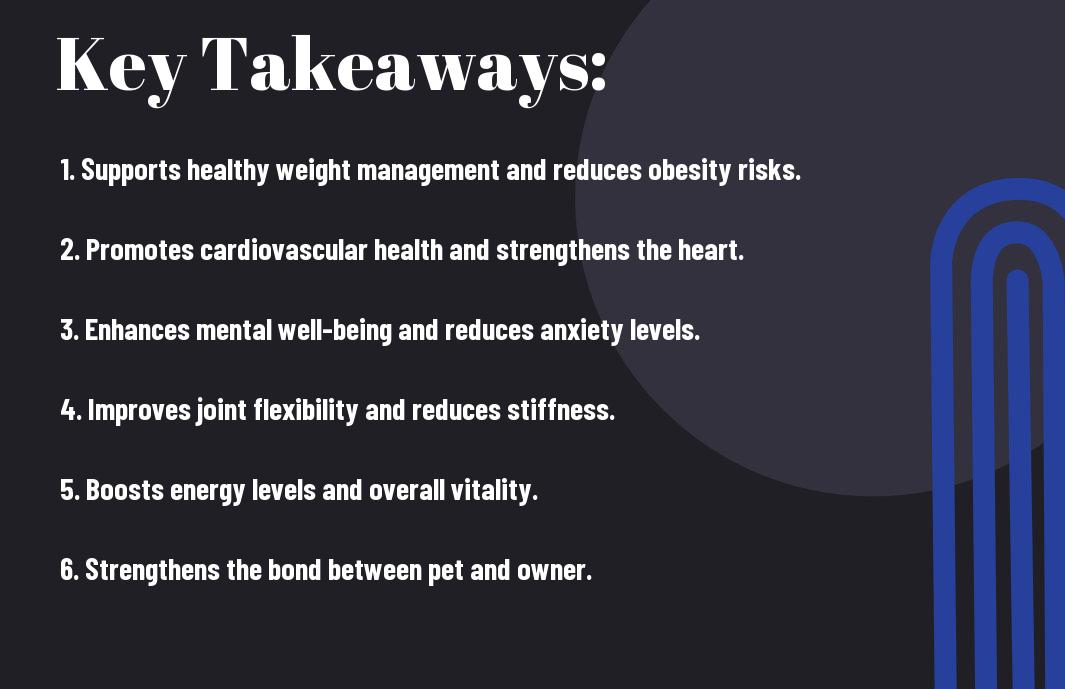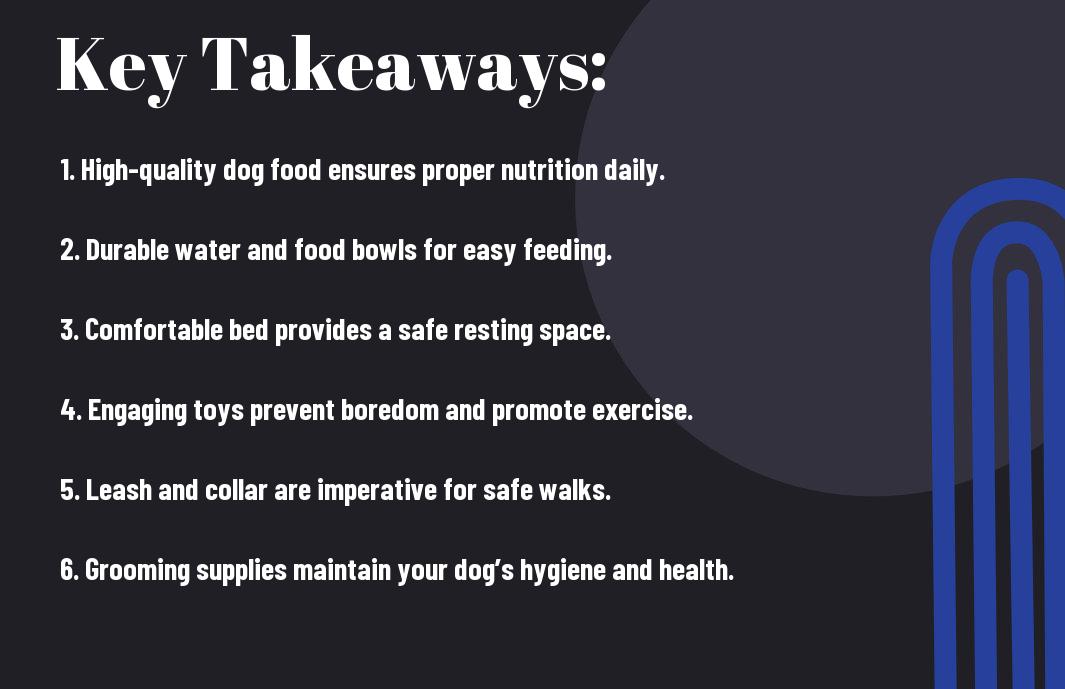Dog ownership brings immense joy, but it comes with the responsibility of keeping your furry friend healthy and happy. Engaging in regular exercise is not just a routine; it is necessary for your dog’s overall well-being. Without adequate physical activity, your pet may experience obesity, behavioral issues, and various health problems. On the other hand, consistent exercise promotes a strong immune system, improves mood, and fosters a deeper bond between you and your canine companion. Prioritizing your dog’s exercise can lead to a happier, healthier life for both of you.


Understanding Your Dog’s Health
Your dog’s health is a vital aspect of their overall well-being and quality of life. Understanding the various elements that contribute to your dog’s health can enable you to provide better care and ensure they live a longer, happier life. Regular check-ups, a balanced diet, and an active lifestyle all play important roles in maintaining your dog’s health. By taking the time to learn about these components, you can help prevent many common health issues and give your furry friend the best life possible.
Importance of Regular Veterinary Check-ups
With the right approach to your dog’s health care, regular veterinary check-ups become a foundational aspect of maintaining their well-being. These check-ups allow your veterinarian to assess your dog’s overall health, monitor for any changes, and catch potential issues early. Furthermore, routine vaccinations and preventative treatments for parasites can ensure that your dog stays protected against various diseases.
With each visit to the veterinarian, you can gain insightful knowledge about your dog’s health. Your vet will provide recommendations tailored to your dog’s breed, age, and lifestyle, making it easier for you to manage their health proactively. Establishing a relationship with a trusted veterinarian can be an excellent resource for addressing any questions or concerns you might have throughout your dog’s life.
Common Health Issues in Dogs
Your dog may face several common health issues throughout their life, which can range from minor to severe conditions. Some of these include obesity, dental disease, allergies, and joint problems. Understanding the symptoms of these issues allows you to act quickly and ensure your dog receives timely medical attention. Additionally, breed-specific problems can arise, making it important to be informed about the particular health risks associated with your dog’s breed.
Common health issues can greatly affect your dog’s quality of life, so it’s necessary to be observant of any changes in behavior or physical condition. Regular exercise can help combat obesity and related health problems, while good oral hygiene practices can prevent dental diseases. Staying proactive and making informed choices about your dog’s well-being will yield positive results in their overall health.
The Role of Nutrition in Canine Health
Against the backdrop of regular exercise, a balanced diet is equally important in maintaining your dog’s health. Providing high-quality, nutritious food tailored to your dog’s life stage, size, and health status can help prevent various health issues and promote optimal growth. A well-rounded diet can influence your dog’s energy levels, coat quality, and even their immune system, so it’s important to prioritize nutrition.
At the same time, it is necessary to avoid overfeeding and to select appropriate dog food that meets all of your dog’s dietary requirements. Consulting with your veterinarian about the best nutritional plan for your dog ensures that they receive the nutrients they need without any harmful additives. Careful attention to your dog’s diet in combination with regular exercise can lead to a long, healthy life filled with joyful moments.
Benefits of Regular Exercise
Assuming you are committed to improving your dog’s well-being, integrating regular exercise into their routine can yield exceptional benefits for their overall health. By ensuring your dog gets sufficient physical activity, you’ll not only enhance their stamina but also significantly improve their quality of life. Regular exercise helps your dogs maintain a healthy weight, boosts their immune system, and reduces their risk of chronic health issues.
Physical Health Benefits
Before exploring into the specifics, it’s important to note that the physical health benefits of regular exercise are extensive. Engaging in daily walks, runs, or playtime can aid in managing your dog’s weight effectively, preventing obesity-related issues such as diabetes and joint problems. It also strengthens their cardiovascular system, keeping their heart healthy and their blood pressure at optimal levels. Furthermore, exercise contributes to building strong muscles and bones, not only helping your dog perform better in daily activities but also prolonging their lifespan.
Mental Health Benefits
One significant aspect often overlooked is the mental health benefits that exercise brings to your dog. Regular physical activity helps reduce anxiety and stress in dogs, particularly those prone to behavioral issues like excessive barking or destructive chewing. Engaging in exercise enables your furry friend to channel their energy positively, preventing boredom and promoting a sense of calmness.
Cardiovascular health isn’t the only benefit; consistent exercise also enhances cognitive function. Dogs that exercise regularly are often more focused and responsive to training, making them easier to manage. This heightened mental engagement helps prevent cognitive decline as they age, ensuring your companion remains sharp and vibrant throughout their life. By prioritizing both the physical and mental aspects of your dog’s health, you create a balanced environment where they can thrive.
Types of Exercise Suitable for Dogs
Despite the various types of exercise available, it’s important to choose suitable activities that cater to your dog’s specific needs and preferences. By providing a diverse range of exercises, you can enhance your dog’s physical health and mental stimulation. Below is a summary of different types of exercises that are beneficial for your furry friend:
| Daily Walks | Walking is crucial for your dog’s physical and mental health. |
| Playtime Activities | Interactive play helps improve your dog’s agility and strength. |
| Structured Exercises and Training | Training sessions can enhance your dog’s obedience and focus. |
| Swimming | A low-impact activity that is great for dogs with joint issues. |
| Outdoor Adventures | Exploring new environments keeps your dog engaged and curious. |
Daily Walks
Along with providing a regular means of exercise, daily walks are vital for your dog’s routine. These outings allow your dog to socialize with other dogs and people, which can contribute to a well-rounded and confident pet. Dogs that experience daily walks tend to exhibit fewer behavioral issues because they are less likely to have pent-up energy.
Moreover, walking provides a perfect opportunity for your dog to explore and experience the environment. Not only does beneficial exercise contribute to your dog’s overall well-being, but it also strengthens the bond between you and your pet, making those moments together even more worthwhile.
Playtime Activities
Below are ways you can incorporate playtime activities into your dog’s routine. Engaging your dog in games like fetch, hide and seek, or tug-of-war can stimulate their mind and body. These fun interactions help to build trust while providing an outlet for energy release. The key to successful playtime is ensuring the activities are varied and enjoyable for your dog.
It’s important to remember that playtime acts as an opportunity for physical and mental engagement. When you keep the activities exciting, your dog will be more inclined to participate, leading to a healthier and happier pet.
But don’t forget to include interactive toys that demand your dog’s attention. Puzzle toys, for example, are excellent for mental stimulation during playtime. Keeping your dog engaged with various activities ensures they remain active while also enjoying their time together.
Structured Exercises and Training
Any form of structured exercises, such as agility training or obedience classes, adds a level of discipline that helps you and your dog communicate better. Training enhances not only physical abilities but also strengthens the bond between you and your pet. It introduces new challenges that keep your dog mentally stimulated and focused.
Incorporating a training schedule into your dog’s exercise routine can reduce boredom and behavioral issues. Whether it’s basic commands or advanced tricks, consistency in training sessions helps reinforce positive behavior, fostering a well-mannered dog.
Walks within structured exercises are also excellent for teaching discipline. When you practice heel commands during your daily walks, for example, it can help improve leash manners and make outings more enjoyable for you both.
Swimming and Other Recreational Activities
Before introducing swimming or other recreational activities, assess your dog’s comfort level with water. Swimming can be a fantastic way for dogs to exercise without putting stress on their joints or paws. It’s also a wonderful way for your dog to cool off during hot weather. Make sure to introduce your dog to the water gradually and always supervise them to ensure their safety.
Swimming sessions offer a full-body workout that improves cardiovascular health while strengthening muscles. Many dogs love the sensation of being in water, which adds a fun element to exercise. You might even consider investing in a dog-friendly life jacket if you’re headed to deeper waters or unfamiliar environments.
Training your dog in swimming techniques or even having fun with a floatable toy can enhance their enjoyment and safety in the water. Make your swimming outings regular to ensure your dog maintains a healthy level of physical activity while taking breaks from typical land-based routines.

Creating an Exercise Routine
Now, as you commence on the journey of creating an exercise routine for your dog, the first step is to ensure that it is tailored to meet your pet’s specific needs. Every dog is unique, with individual preferences, energy levels, and health considerations. Assessing your dog’s needs should involve considering their age, breed, size, and any pre-existing health conditions. Puppies may have high energy and need frequent playtime, while older dogs may benefit from gentler, shorter walks. Understanding these requirements will be important in planning an effective routine.
Assessing Your Dog’s Needs
Creating an exercise regimen starts with observing your dog’s behavior and activity levels. Signs of boredom or restlessness may indicate a need for more physical activity, whereas excessive fatigue might suggest that your dog is being over-exercised. Consult with your veterinarian if you’re unsure about how much exercise is appropriate for your dog, especially if they have health concerns or are recovering from an illness.
Gradual Introduction to Exercise
Against the backdrop of establishing a healthy exercise routine, it is vital to introduce physical activities gradually. If your dog has been relatively inactive, jumping right into an intensive exercise plan can lead to injuries or fatigue. Start with short, manageable sessions of play or walking, gradually increasing the duration and intensity as your dog becomes more accustomed to the routine. This safe approach helps in building their endurance and strength over time.
Routine adjustments may also be necessary as you notice your dog’s response to exercise. Positive progress typically involves your dog showing more enthusiasm as they develop their stamina. Keep an eye on their energy levels and consider varying activities to keep them engaged, such as mixing walks with games of fetch or agility training once they are acclimated.
Establishing a Consistent Schedule
On the path to creating a comprehensive exercise schedule, consistency is key. Dogs thrive on routine, and having a set time for their daily exercise not only helps them anticipate fun activities but also reinforces good behavior. By incorporating exercise into your daily life as a regular occurrence, you establish a structure that can improve your dog’s overall well-being.
It can be helpful to designate specific days and times for exercise and stick to them as closely as possible. Set reminders for yourself, and incorporate exercises that can easily fit into your daily schedule, whether it’s a morning jog or an evening play session in the yard. Sticking to a consistent schedule will foster habits for both you and your dog, making it easier for you both to enjoy the time spent together.
For instance, if you decide on a morning walk before breakfast and an afternoon play session, try to keep these times as your go-to moments. This not only aids in establishing a balanced routine, but also strengthens the bond you have with your dog, enhancing the joy of shared experiences and healthy living.
Safety Considerations
All dog owners need to be vigilant about ensuring their dog’s safety during exercise. Just like humans, dogs can experience exhaustion or even injury if they overexert themselves. Understanding how to recognize signs of overexertion in your pet can help prevent serious health issues. By watching for symptoms such as excessive panting, staggering, or reluctance to continue exercising, you can make informed decisions about when to allow your dog to rest. If your furry friend exhibits any of these signs, it’s vital to stop the activity immediately and provide them with water and a comfortable space to recover.
Recognizing Signs of Overexertion
Behind every energetic play session is the potential for your dog to overdo it. You should be mindful of their behavior during exercise, keeping an eye out for any changes that may signal they’re pushing themselves too hard. If your dog starts to lag behind or seems disinterested in their surroundings, consider that they might be feeling worn out. Additionally, keep an eye on their tongue color; a bright red or blue tongue can indicate overheating or distress.
Weather Considerations
Around your dog’s exercise routine, weather plays a significant role in their safety and well-being. Variations in temperature can have different effects on your dog depending on their breed, age, and health status. In hot weather, dogs are susceptible to overheating. Always plan your walks or play sessions during cooler parts of the day, such as early morning or late evening. Carry water to keep your dog hydrated, and be on the lookout for any signs of heat-related stress.
At the other end of the spectrum, cold weather can pose risks as well. Dogs can suffer from cold-weather ailments, especially small or short-haired breeds. Make sure to adjust the length of your exercise sessions according to the temperature, and consider using protective gear like dog sweaters or booties if conditions are particularly frigid. Knowing how to respond to the weather conditions ensures you keep your dog safe and happy while being active outside.
Age and Breed-Specific Exercise Needs
Below the surface of general exercise recommendations lies the fact that not all dogs require the same amount of activity. Different breeds have varying energy levels, and older dogs may have reduced stamina compared to their younger counterparts. It’s vital to tailor exercise routines based on your dog’s age, breed, and health. For example, high-energy breeds like Border Collies may thrive with extensive daily exercise, while smaller or senior dogs might be content with shorter, gentler walks.
Weather can also influence how much exercise your dog needs. For instance, puppies typically have high energy levels but tire quickly, requiring you to adjust your play sessions accordingly. Conversely, older dogs may need more frequent, short bursts of exercise with ample downtime. Always consider your dog’s unique characteristics to optimize their health and enjoyment from exercise.
Involving the Entire Family
Unlike many activities that may seem exclusive to adults or specific family members, involving your entire family in your dog’s exercise routine creates a fun and engaging atmosphere. It allows everyone to participate and contributes to your dog’s overall happiness and health. By making exercise a shared family endeavor, it becomes much more enjoyable and motivates everyone to stick to a routine. Plus, it helps foster a sense of unity, allowing every member to connect not only with the dog but also with each other through the shared goal of improving your furry friend’s health.
Making Exercise a Family Activity
Among the various ways to engage your family, consider planning regular walking, jogging, or hiking sessions with your dog. This not only provides important physical activity for your pup but also serves as an opportunity for you and your family to bond while enjoying the outdoors. You can also incorporate activities like playing fetch, frisbee, or agility training to spice things up, ensuring that your dog remains entertained and engaged during exercise. Taking turns in leading the activities can also make it fun and share the responsibility of your dog’s exercise needs among family members.
Engaging Children in Playtime
Activity can thrive when children are involved in your dog’s exercise routine. Children are naturally energetic and can bring a burst of enthusiasm to playtime, making it much more exciting for your dog. Organizing games such as hide-and-seek, tug-of-war, or even training sessions can create a fun environment where both kids and the dog enjoy themselves. Moreover, it teaches children the importance of caring for a pet, as they understand that physical activity contributes significantly to a dog’s well-being.
Due to this engagement, children can develop a sense of responsibility towards your dog, fostering a lifelong love for animals as they learn to recognize and respond to the needs of a pet. Exercise becomes a platform for teaching valuable lessons about empathy and care. You’ll also find that your kids are more likely to remain active themselves, so long as there is a furry companion encouraging them to play and run around.
Building Bonds Through Physical Activity
Against the backdrop of busy family schedules, prioritizing regular physical activity can significantly improve not only your dog’s health but also strengthen the bonds within your family. Engaging together in exercise allows family members to relate on common ground while building cherished memories. This collaborative effort encourages teamwork, reduces stress, and helps develop a nurturing atmosphere in your home.
Engaging in physical activity as a family cultivates mutual respect and understanding among family members and your dog. It becomes a beacon of shared experiences, where everyone learns the importance of commitment and dedication to promoting each other’s health and well-being. Ultimately, the strong bond that develops through such shared experiences enriches everyday life, making your household a happier and more harmonious place.
To wrap up
To wrap up, incorporating regular exercise into your dog’s routine is important for maintaining their overall health and well-being. Not only does it help manage their weight, but it also strengthens their cardiovascular system, promotes healthy digestion, and enhances their mental stimulation. By engaging in daily walks, play sessions, and interactive activities, you are providing your dog with the physical and mental challenges they need to thrive. This can result in a happier, more balanced pet who exhibits less behavioral issues.
Moreover, regular exercise builds a stronger bond between you and your furry friend. Sharing these activities not only improves their health but also fosters companionship and allows you to observe and understand their unique personality better. To ensure a long, fulfilling life for your dog, prioritize their exercise needs tailored to their age, breed, and energy level. With your commitment, you can pave the way for a healthier and happier life for both you and your beloved dog.
Q: What are the specific health benefits of regular exercise for my dog?
A: Regular exercise offers numerous health benefits for dogs, including maintaining a healthy weight, improving cardiovascular health, and promoting strong muscles and joints. It helps prevent obesity, which can lead to various health issues such as diabetes and arthritis. Additionally, exercise can enhance your dog’s mood and reduce anxiety, contributing to overall mental well-being.
Q: How much exercise does my dog need on a regular basis?
A: The amount of exercise your dog requires depends on several factors, including its age, breed, and health status. Generally, most dogs need at least 30 minutes to two hours of exercise each day, which can be divided into walks, playtime, or other activities. Puppies and high-energy breeds may require more vigorous activities, while older or less active dogs might benefit from shorter, more frequent exercise sessions.
Q: What types of exercises are most beneficial for my dog?
A: There are various types of exercises that can be beneficial for your dog. Walking and running are popular options, but you can also incorporate activities like fetch, agility training, swimming, or interactive play with toys. It is important to vary the routine to keep your dog engaged and stimulated while catering to its individual interests and physical capabilities.










